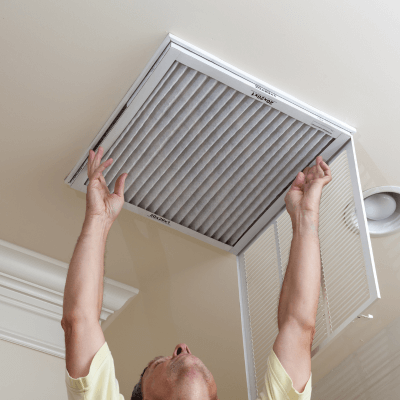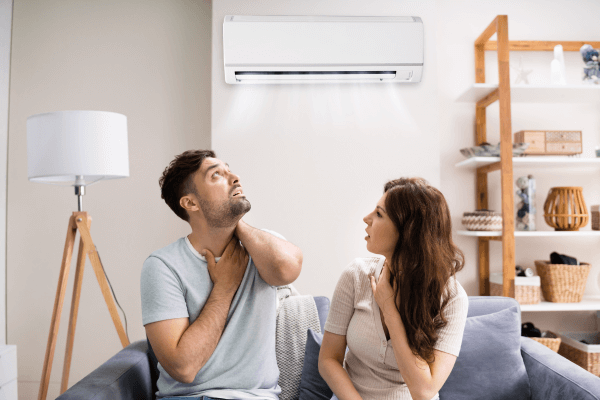If you’re like most folks in Austin, Texas, your air conditioning is practically a lifesaver during those scorching summer days. But what if I told you that the cool air you rely on might be hiding something a bit more sinister—like mold? Yep, that’s right. Mold can find its way into your HVAC system, and when it does, it can create some serious problems for both your health and your home.
Let’s dive into why mold in your air conditioning system is such a big deal, how to spot it, and most importantly, what you should do about it. We’ll also share some handy tips on how to keep your HVAC system mold-free so you can breathe easy, knowing your home is safe.
How Does Mold Get Into Your Air Conditioning?
First off, let’s talk about how mold ends up in your HVAC system in the first place. Mold is a type of fungus that loves damp, humid environments (sound familiar?). Austin’s climate can be the perfect playground for mold, and if your air conditioning system isn’t well-maintained, it can quickly become a mold magnet.
Here are some common ways mold sneaks into your air conditioning:
- Condensation: Your AC works hard to cool down your home by removing heat and moisture from the air. This process creates condensation, which can build up in the system. If that moisture isn’t properly drained, mold can start growing like it’s on vacation.
- Dirty Filters: Your HVAC filters are designed to catch dust, pollen, and other pesky particles. But if you don’t change them regularly, they can get clogged and damp—an open invitation for mold.
- Leaky Ductwork: If your ductwork has leaks or isn’t properly insulated, it can let in moisture. And where there’s moisture, mold isn’t far behind.
- Skipping Maintenance: Over time, dust and debris can pile up inside your HVAC system. If you skip regular cleanings and check-ups, that gunk can hold moisture and become a breeding ground for mold.
Why Is Mold in Your Air Conditioning Dangerous?
So, what’s the big deal about mold in your air conditioning? Well, when your HVAC system is running, it’s not just blowing cool air—it’s also potentially blowing mold spores throughout your home. And that’s where things get tricky.

Health Risks from Mold Exposure:
- Breathing Issues: Mold spores can irritate your lungs and airways, causing coughing, wheezing, and even triggering asthma attacks.
- Allergies: Many people are allergic to mold. If you are, you might experience sneezing, a runny nose, red eyes, or even skin rashes after being exposed.
- Sinus Problems: Mold spores can lead to chronic sinus infections, which are no fun at all and tough to kick without tackling the mold issue first.
- Toxic Mold: Some types of mold, like the infamous black mold (Stachybotrys chartarum), can produce toxins that cause serious health problems, including neurological symptoms and chronic fatigue.
Damage to Your Home:
Mold isn’t just bad for your health; it can also do a number on your home. Mold spores can spread through your HVAC system, settling in other parts of your home and leading to musty odors, stains, and even structural damage. Plus, mold damage can lower your property value, which is a headache no homeowner wants to deal with.
How to Spot Mold in Your Air Conditioning
Mold can be sneaky, especially when it’s hiding inside your HVAC system. But there are a few telltale signs that can help you catch it before it gets out of hand:
- Musty Smell: If your home smells musty whenever the air conditioning is on, that’s a pretty strong sign you’ve got mold lurking somewhere in the system.
- Visible Mold: While mold inside the HVAC system might be out of sight, you might notice it around air vents, drip pans, or in your ductwork.
- Health Symptoms: If you or your family start experiencing unexplained respiratory issues, allergies, or sinus problems—especially when the AC is running—it could be mold.
- Humidity Issues: If your air conditioner isn’t keeping your home’s humidity in check, mold could start growing more easily.
- AC Troubles: If your HVAC system is constantly breaking down, has poor airflow, or your energy bills are mysteriously climbing, mold could be to blame.
What to Do If You Suspect Mold in Your Air Conditioning
If you think you’ve got mold in your HVAC system, don’t panic—but do take action. Here’s what you need to do:
- Turn Off the AC: First things first, shut down your HVAC system to stop mold spores from circulating throughout your home.
- Call in the Pros: Mold isn’t something you want to mess with on your own. Get a professional mold inspection to find out exactly what’s going on. At Howard Environmental, we specialize in thorough mold inspections and testing to make sure nothing gets missed.
- Test the Air Quality: Along with a visual inspection, it’s a good idea to test your home’s air quality to see if mold spores are floating around. This can give you a clearer picture of the potential health risks.
- Skip the DIY: DIY mold removal can do more harm than good. Without proper containment, you could end up spreading mold spores all over the place. Since we at Howard Environmental focus on testing and inspection, we can give you unbiased advice without any pressure to buy remediation services.
- Hire a Mold Remediation Expert: Once you know you’ve got mold, the next step is to get it out of your home safely. While we don’t handle remediation ourselves, we recommend All Nation Restoration for any restoration needs.
- Keep Up with HVAC Maintenance: The best way to avoid mold in the future is regular HVAC maintenance. Change those filters, clean the ductwork, and make sure condensation is draining properly.
How to Prevent Mold in Your HVAC System

Prevention is key when it comes to mold. Here are some tips to help keep your HVAC system mold-free:
- Change Filters Regularly: Make it a habit to replace your HVAC filters every three months—or more often if you have allergies or pets.
- Keep Things Dry: Make sure your air conditioning unit is draining properly. If you spot standing water or excess moisture, deal with it right away.
- Get Annual Inspections: Have your HVAC system inspected and cleaned at least once a year to keep everything running smoothly and mold-free.
- Use a Dehumidifier: In humid climates like ours, a dehumidifier can help keep indoor humidity levels low, making it tougher for mold to grow.
For more detailed info on how mold can impact your health, check out this helpful guide from the EPA.
Let’s Keep Your Home Mold-Free
If you’re worried about mold in your air conditioning or just want to stay ahead of the game, Howard Environmental is here to help. Our professional mold testing and inspection services can give you peace of mind, knowing your home’s air is clean and safe.Don’t wait until mold becomes a bigger problem—schedule your inspection with Howard Environmental today! Give us a call or book your appointment online, and let’s make sure your home stays mold-free and comfortable all year long.

